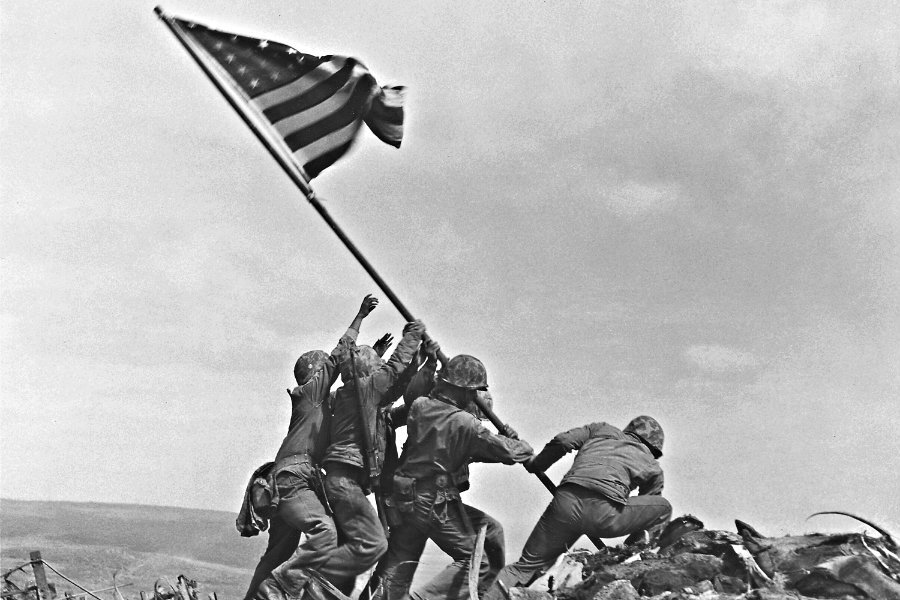Who was the mysterious sixth Marine in the iconic Iwo Jima photo?
The photograph of American Marines raising the flag on Iwo Jima during World War II is one of the most iconic images in American history. It has been debated, replicated, and parodied for decades. On Thursday, the Marine Corps announced that one of the six men in the photo had been misidentified for years.
Many know that the now iconic photograph actually depicts the second flag raising of the day after the strategically critical capture of Mount Suribachi on the Japanese island of Iwo Jima. Yet mystery still shrouds the decades old photograph.
For years, the Marine Corps thought they had correctly identified all six men in the photograph, which was taken by Associated Press photographer Joe Rosenthal, only to have doubts raised by amateur historians. Now, it appears that the historians have finally identified the last mystery man, Private 1st Class Harold Schultz, who passed on in 1995.
"Although we will never be 100 percent sure," historian Charles Neimeyer told The Christian Science Monitor by phone, "we are fairly certain of the identities of all six people now. We took our time with this investigation."
For years, many believed that John Bradley, father of author James Bradley (of "Flags of Our Fathers" fame), was one of the six men. Mr. Bradley's likeness was even featured on the Iwo Jima monument that stands near Arlington Cemetery.
Yet this investigation formally debunked that idea, and further surfaced evidence that one quiet Marine had been one of the photograph's six flag raisers.
Private 1st Class Harold Schultz, a Marine who moved to Los Angeles after the war, was a mail sorter with the United States Postal Service. Mr. Schultz only once mentioned that he was one of the flag raisers, mentioning it quietly at dinner with his family. He never mentioned his involvement with the famous photograph publicly.
"It was clear he didn’t want to talk about it," his stepdaughter Derzeen Macdowell told The New York Times. "He was a very self-effacing Midwestern person."
Schultz passed on in 1995, effectively eschewing his chance at fame. His involvement in the flag raising only became known because of work on a Smithsonian documentary called "The Unknown Flag Raiser of Iwo Jima," which will air July 3 on the Smithsonian Channel.
Another one of the flag raisers, Ira Hayes, asked to remain anonymous after the photograph was released on the front pages of dozens of American newspapers, but the Marine Corps ordered the known Marines to tour in an effort to raise morale and sell war bonds.
During the first battle that occurred in Japan's inner defense zone, 6,800 US Marines died on Iwo Jima. According to Dr. Neimeyer, the fall of Iwo Jima meant that the way was open for the invasion of Japan's home islands.
How much does this discovery change things? Many say that it doesn't really matter much at all.
According to Douglas Nickel, the Andrea V. Rosenthal Professor of Modern Art at Brown University, the photo's composition is such that the faces of the men pictured are largely obscured, making the photograph much more about what the soldiers stood for and meant to the public, rather than about the soldiers as individuals.
"While modern forensic investigation can now work miracles in correcting the historical record," Professor Nickel wrote to the Monitor by email, "whether or not the figure on the right of the photograph was indeed named Bradley or Schulz makes little difference to our understanding of it as symbolizing battlefield heroism."
General Robert Neller, commandant of the Marine Corps, was behind the appointment of the panel of historians that investigated the photograph.
"Simply stated, our fighting spirit is captured in that frame, and it remains a symbol of the tremendous accomplishments of our corps," wrote General Neller in a statement, "what they did together and what they represent remains most important. That doesn't change."






